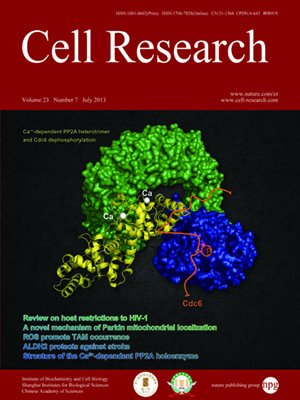
Volume 23, No 7, Jul 2013
ISSN: 1001-0602
EISSN: 1748-7838 2018
impact factor 17.848*
(Clarivate Analytics, 2019)
Volume 23 Issue 7, July 2013: 931-946
ORIGINAL ARTICLES
Structure of the Ca2+-dependent PP2A heterotrimer and insights into Cdc6 dephosphorylation
Nathan Wlodarchak1,*, Feng Guo1,*, Kenneth A Satyshur1, Li Jiang1, Philip D Jeffrey2, Tingwan Sun3, Vitali Stanevich1, Marc C Mumby3 and Yongna Xing1
1McArdle Laboratory, Department of Oncology, University of Wisconsin-Madison, School of Medicine and Public Health, Madison, WI, USA
2Department of Molecular Biology, Princeton University, Princeton, NJ, USA
3Department of Pharmacology, University of Texas Southwestern Medical Center, Dallas, TX, USA
Correspondence: Yongna Xing(xing@oncology.wisc.edu)
The B″/PR72 family of protein phosphatase 2A (PP2A) is an important PP2A family involved in diverse cellular processes, and uniquely regulated by calcium binding to the regulatory subunit. The PR70 subunit in this family interacts with cell division control 6 (Cdc6), a cell cycle regulator important for control of DNA replication. Here, we report crystal structures of the isolated PR72 and the trimeric PR70 holoenzyme at a resolution of 2.1 and 2.4 Å, respectively, and in vitro characterization of Cdc6 dephosphorylation. The holoenzyme structure reveals that one of the PR70 calcium-binding motifs directly contacts the scaffold subunit, resulting in the most compact scaffold subunit conformation among all PP2A holoenzymes. PR70 also binds distinctively to the catalytic subunit near the active site, which is required for PR70 to enhance phosphatase activity toward Cdc6. Our studies provide a structural basis for unique regulation of B″/PR72 holoenzymes by calcium ions, and suggest the mechanisms for precise control of substrate specificity among PP2A holoenzymes.
10.1038/cr.2013.77
FULL TEXT | PDF
Browse 6751


